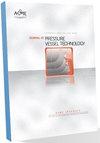考虑焊接顺序的SUS304/Q235双金属复合板对接接头残余应力演化研究
IF 1
4区 工程技术
Q4 ENGINEERING, MECHANICAL
Journal of Pressure Vessel Technology-Transactions of the Asme
Pub Date : 2022-02-16
DOI:10.1115/1.4053879
引用次数: 0
摘要
残余应力的预测和控制对焊件结构完整性评估具有重要意义。在现有的工作中,结合有限元和实验方法,研究了焊接顺序对SUS304/Q235双金属复合板多层多道焊接头的影响。结果表明,飞片表面残余应力峰值受焊接顺序的影响较小,但先焊基层接头的高表面纵向应力区宽度较大。同时,焊接顺序对接头内部的纵向残余应力演化规律有很大影响。当首先焊接基底焊缝层时,过渡层出现最大应力集中。然而,当首先焊接飞片焊缝层时,由于马氏体相变,它将被转移到第一基底焊缝层中。双金属复合板接头中残余应力的控制应引起研究者的重视。本文章由计算机程序翻译,如有差异,请以英文原文为准。
Study of Residual Stress Evolution in SUS304/Q235 Bimetallic Clad Plate Butt-Welded Joints Considering Welding Sequence
Residual stress prediction and controlling is important for structural integrity assessment of weldments. In current work, finite element and experimental methods were integrated to study the influence of welding sequence on the SUS304/Q235 bimetallic clad plate joints during multi-layer and multi-pass welding. The results show that the peak residual stress values on flyer plate surface are weakly affected by welding sequences but the width of high surficial longitudinal stress area of joint with base layer welded first is bigger. Meanwhile, welding sequence has a great influence on the longitudinal residual stress evolution law inside joints. When base seam layer is welded first, the highest stress concentration appears in the transition layer. However, it would be transferred into the first base seam layer due to martensite phase transformation when flyer seam layer is welded first. Residual stress controlling in the bimetallic clad plate joint should attract more attention from researchers.
求助全文
通过发布文献求助,成功后即可免费获取论文全文。
去求助
来源期刊
CiteScore
2.10
自引率
10.00%
发文量
77
审稿时长
4.2 months
期刊介绍:
The Journal of Pressure Vessel Technology is the premier publication for the highest-quality research and interpretive reports on the design, analysis, materials, fabrication, construction, inspection, operation, and failure prevention of pressure vessels, piping, pipelines, power and heating boilers, heat exchangers, reaction vessels, pumps, valves, and other pressure and temperature-bearing components, as well as the nondestructive evaluation of critical components in mechanical engineering applications. Not only does the Journal cover all topics dealing with the design and analysis of pressure vessels, piping, and components, but it also contains discussions of their related codes and standards.
Applicable pressure technology areas of interest include: Dynamic and seismic analysis; Equipment qualification; Fabrication; Welding processes and integrity; Operation of vessels and piping; Fatigue and fracture prediction; Finite and boundary element methods; Fluid-structure interaction; High pressure engineering; Elevated temperature analysis and design; Inelastic analysis; Life extension; Lifeline earthquake engineering; PVP materials and their property databases; NDE; safety and reliability; Verification and qualification of software.

 求助内容:
求助内容: 应助结果提醒方式:
应助结果提醒方式:


